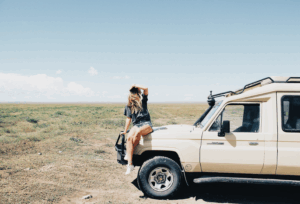If you’re wondering what to wear on safari, this guide will help you dress smartly for every stage of your adventure.
Why Your Safari Outfit Matters
Safari environments can be unpredictable. Mornings are chilly, midday is hot, and evenings often come with sudden breezes or insects. Your clothing should keep you comfortable through all these changes while blending in with nature and protecting you from sun, dust, and bugs.
It’s not about looking fashionable—it’s about feeling prepared.
1. Game Drives: The Safari Classic
When? Early mornings and late afternoons
Conditions? Open 4×4 vehicles, wind exposure, temperature changes
What to wear:
Long-sleeve neutral-colored shirt (khaki, olive, beige)
Lightweight cargo pants or breathable trousers
A light fleece or windbreaker for cool starts
Closed-toe shoes or hiking sneakers
Wide-brimmed hat for sun protection
Sunglasses and a scarf or buff (to protect from dust)
Avoid: Bright colors (they scare wildlife), dark blue or black (they attract tsetse flies)
2. Walking Safaris and Bush Walks
When? Midday or morning, with a guide
Conditions? Tall grass, uneven terrain, sun exposure
What to wear:
Long-sleeve breathable shirt with sun protection
Durable, lightweight hiking pants
Sturdy hiking boots or trekking shoes
High socks to tuck pants in (tick prevention)
Insect repellent and optional gaiters
This is one of the few times you’ll be on foot in the bush, so blend in with surroundings and prioritize coverage.
3. Lodge and Camp Wear
When? Afternoons, dinners, relaxing between drives
Conditions? Comfortable, casual, sometimes a bit dusty
What to wear:
Cotton T-shirt or linen shirt
Comfortable shorts or pants
Sandals or slip-on shoes
Light sweater or cardigan for cooler evenings
You don’t need formal wear—even luxury lodges have a relaxed dress code. Think breathable, casual, and clean.
4. Evening Campfire or Stargazing
When? After sunset
Conditions? Mosquitoes, cooler temperatures
What to wear:
Long sleeves and long pants to cover skin
Insect-repellent clothing or spray
Fleece jacket or hoodie
Lightweight beanie or scarf (optional)
You’ll be thankful for layers when temperatures drop at night.
5. Travel Days and Airport Transfers
When? Arrival, departure, or domestic flights
Conditions? Varying climates, luggage limitations
What to wear:
Comfortable, layered outfit (e.g., T-shirt + hoodie + travel pants)
Easy-to-remove shoes for airport security
Packable rain jacket in hand luggage
Neck pillow and compression socks (optional for longer flights)
Choose clothes you can re-wear during the trip to minimize packing.
Safari Clothing Tips
Stick to neutral tones. They don’t attract insects or scare animals.
Avoid camouflage prints. In many African countries, it’s illegal for civilians.
Choose quick-dry, breathable fabrics. They handle sweat and dust better.
Pack light. Many bush planes have strict weight limits.
Bring layers. Safaris involve daily temperature swings.
Final Thoughts
If you’ve been asking what to wear on safari, the answer is simple: dress in layers, choose function over fashion, and stick to nature-blending colors. Whether you’re cruising through game reserves, walking among wildlife, or relaxing at a campfire, your safari outfit plays a big role in how comfortable—and prepared—you feel.
The right clothing won’t just help you stay safe. It will let you focus on the real magic: the wild, untamed beauty all around you.
